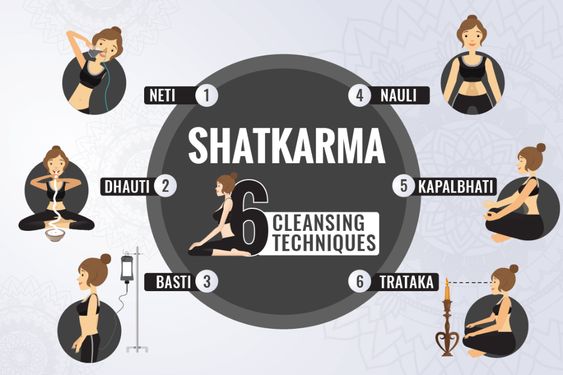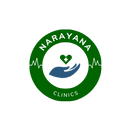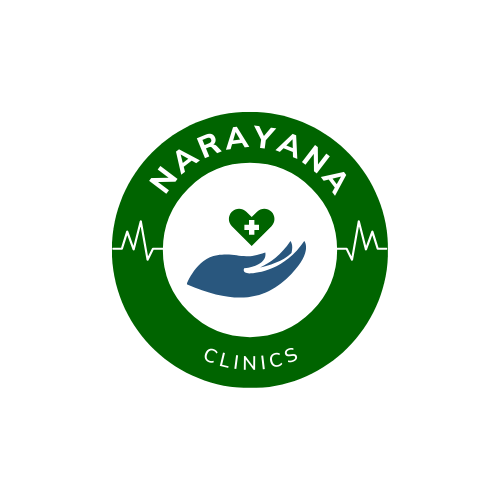Shatkarma
Shatkarma (Shatkriya) is a set of six yogic purification techniques designed to cleanse and purify the body, mind, and energy channels. These practices, outlined in ancient yogic texts like the Hatha Yoga Pradipika, are essential for preparing the body and mind for deeper yogic practices such as Pranayama and meditation.

Detailed Procedure of Shatkarma
These practices, outlined in ancient yogic texts like the Hatha Yoga Pradipika, are essential for preparing the body and mind for deeper yogic practices such as Pranayama and meditation.
1. Neti (Nasal Cleansing)
Neti involves the cleansing of the nasal passages to remove excess mucus, dirt, and pollutants.
a) Jala Neti (Water Nasal Cleansing)
- Materials Needed: Neti pot, lukewarm saline water (saltwater solution).
- Procedure:
- Fill the Neti pot with lukewarm saline water (use about half a teaspoon of salt per 500 ml of water).
- Tilt your head sideways and insert the spout of the Neti pot into the upper nostril.
- Open your mouth slightly and breathe through it. Let the water flow through the upper nostril and exit from the lower nostril.
- After flushing one side, blow out any excess water gently from both nostrils. Repeat on the other side.
- Once both nostrils are clean, gently blow out any remaining water.
Benefits: Clears the nasal passages, enhances breathing, and helps with allergies, sinus issues, and respiratory problems.
b) Sutra Neti (Thread or Catheter Cleansing)
- Materials Needed: A soft, rubber catheter or a waxed cotton thread.
- Procedure:
- Lubricate the thread or catheter.
- Insert it slowly and gently into one nostril, pushing it back until it reaches the throat.
- Using your fingers, pull the thread out through your mouth.
- Hold both ends and gently floss the nasal passage.
Benefits: Removes deep-seated mucus and blocks in the nasal cavity, and improves nasal sensitivity.
2. Dhauti (Cleansing of the Digestive Tract)
Dhauti purifies the upper digestive tract, stomach, and esophagus.
a) Vamana Dhauti (Kunjal Kriya) – Stomach Cleansing
- Materials Needed: Lukewarm saline water.
- Procedure:
- Early in the morning, on an empty stomach, drink 6-8 glasses of lukewarm saline water quickly.
- Stand upright and gently massage your abdomen.
- Lean forward, insert two fingers into your throat, and induce vomiting to expel the water.
Benefits: Cleanses the stomach of undigested food, mucus, and toxins. It helps in digestive issues, acidity, and lung-related problems.
b) Vastra Dhauti (Cloth Cleansing)
- Materials Needed: A clean cotton cloth, about 3-4 meters long and 5 cm wide.
- Procedure:
- Swallow the cloth slowly, drinking water to aid the process.
- The cloth will absorb impurities from the stomach and esophagus.
- After swallowing the cloth, wait for a few minutes, then gently pull it out, ensuring a smooth removal without jerking.
Benefits: Effective for cleansing the stomach and digestive tract, helps with indigestion, and strengthens the abdominal region.
c) Danta Dhauti (Teeth and Mouth Cleansing)
- Involves cleaning the teeth, tongue, and throat with herbal powders, oils, or soft fingers. It removes toxins from the oral cavity, improving oral hygiene.
3. Nauli (Abdominal Massage/Cleansing)
Nauli involves massaging the abdominal muscles to purify and strengthen the digestive system.
Procedure:
- Stand with feet shoulder-width apart and slightly bend forward.
- Place your hands on your thighs and exhale fully, performing Uddiyana Bandha (abdominal lock).
- Now, contract the central abdominal muscles and create a wave-like motion by isolating and rotating the abdominal muscles from side to side (this is called Nauli).
- Repeat several times, focusing on the movement of the abdominal muscles.
Benefits: Stimulates and tones the digestive organs, improves digestion, balances the endocrine system, and enhances energy flow in the body.
4. Basti (Colon Cleansing)
Basti is a yogic enema technique used for cleansing the colon and lower intestines.
a) Jala Basti (Water Enema)
- Procedure:
- Sit in a shallow tub filled with lukewarm water.
- Insert a soft tube or catheter into the rectum while sitting in a squat position.
- Create suction using the abdominal muscles to draw water into the colon.
- After a few minutes, expel the water naturally, releasing the contents of the intestines.
b) Sukha Basti (Dry Enema)
- Performed without water, using abdominal muscles to suction air into the rectum for cleansing.
Benefits: Cleanses the large intestine, helps with constipation, detoxifies the digestive system, and improves bowel function.
5. Kapalbhati (Skull-Shining Breath or Cleansing Breath)
Kapalbhati is a pranayama technique that cleanses the respiratory system and energizes the mind.
Procedure:
- Sit comfortably with your spine straight.
- Inhale normally, then exhale forcefully by contracting your abdominal muscles (focus on the exhalation).
- Allow the inhalation to happen naturally as a passive process after each forced exhalation.
- Repeat this rapid, forceful exhalation process for about 20-30 breaths in one round.
Benefits: Cleanses the lungs, removes carbon dioxide, improves respiratory efficiency, and enhances mental clarity. It also strengthens the diaphragm and abdominal muscles.
6. Trataka (Concentration and Cleansing of the Eyes)
Trataka is a practice of gazing steadily at a fixed object, usually a candle flame, to cleanse and strengthen the eyes and mind.
Procedure:
- Sit comfortably in a dark room with a lit candle placed at eye level, about 2-3 feet away.
- Gaze steadily at the flame without blinking, focusing on the tip of the flame.
- Keep your focus until your eyes begin to water.
- Close your eyes and visualize the flame in your mind’s eye, focusing on the afterimage.
- Repeat the process for 5-10 minutes.
Benefits: Improves vision, concentration, and mental clarity. It helps in reducing eye strain and developing inner focus.
Key Benefits of Shatkarma
- Cleanses the body’s internal organs and systems.
- Improves digestion, circulation, and respiratory functions.
- Balances energy flow (prana) in the body.
- Prepares the body for advanced yoga practices like Pranayama and meditation.
- Helps remove physical and mental blockages, creating harmony in the mind-body connection.
Precautions
- Shatkarma should be practiced under the guidance of an experienced yoga teacher or Ayurvedic practitioner, especially for beginners.
- People with certain medical conditions (e.g., heart problems, respiratory issues, or pregnancy) should consult a professional before performing these techniques.
Shatkarma is a powerful tool for deep purification and transformation when done correctly and consistently.

